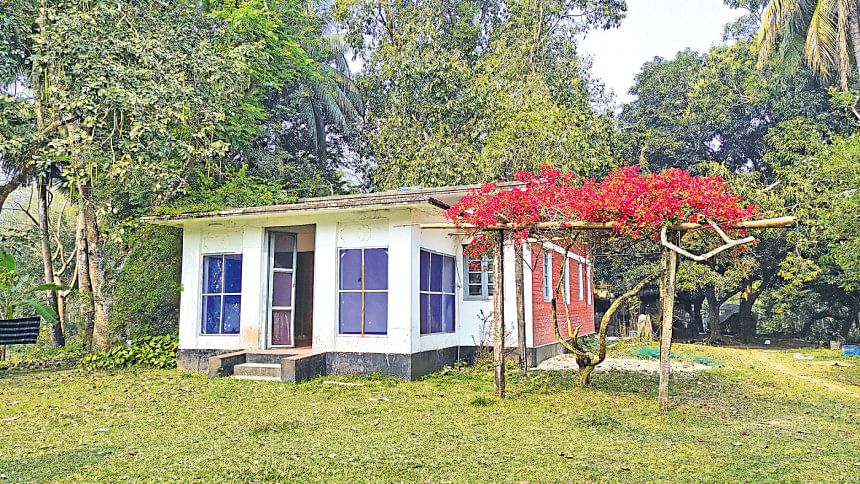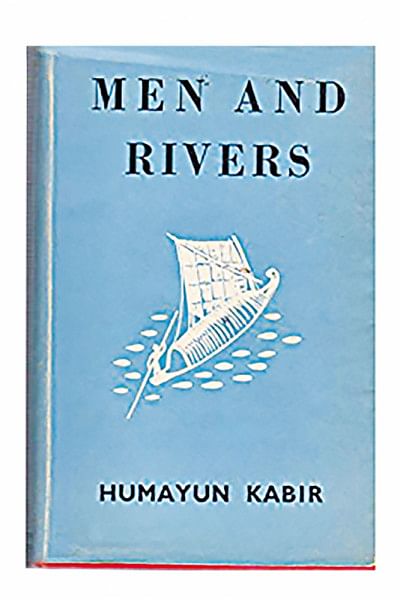Humayun Kabir, Men and Rivers, and Faridpur

Kabir self-translated Men and Rivers into Bangla under the title of Nadi O Nari. In this he followed the example of Rokeya who wrote "Sultana's Dream" (1905) in English and then self-translated it into Bangla.
Writer, statesman and educationalist Humayun Kabir (1906-69) was born in Komarpur near Faridpur town. The childhood of this cosmopolitan intellectual was spent in a rural culture. He chose India as his home at the 1947 Partition and later became a minister in the Indian government, holding the portfolios of scientific research and cultural affairs and education. Because of his birth and upbringing in what is now Bangladesh, we consider him a Bangladeshi writer. For the same reason, Rokeya Sakhawat Hossain and Nirad C. Chaudhuri are also regarded as Bangladeshis. Accordingly, dubbed as the national encyclopaedia of Bangladesh, Banglapedia has entries on all these three writers.
Like that of most other Bangladeshi Anglophone writers, Kabir's remarkable literary career was apparently inspired by his education in English literature. He completed his first degrees in English at the University of Calcutta with distinction before studying Modern Greats (Philosophy, Politics and Economics) at Oxford where he obtained the first rank in the Honours Examination. Furthermore, as the formative period of his life coincided with the British colonial presence in South Asia, conceivably, his Anglophone writing practice was also stirred by his interactions with Anglo-Indians living in the region.
At Oxford, Kabir was deeply involved in organisational and literary activities. Following the model of the Cambridge Union (est. 1815) and the Oxford Union (est. 1823), students from British India at Cambridge and Oxford Universities formed the Cambridge Majlis (est. 1891) and the Oxford Majlis (est. 1896), respectively. Again, patterning upon the practice adopted in the Cambridge and Oxford Unions, Indian students of the Cambridge Majlis and the Oxford Majlis organised weekly debates. Kabir was active in both the Oxford Union and the Oxford Majlis.
The writer Dosoo Framjee Karaka (1911-74) went to Oxford in 1930, two years after Kabir, and later became the first Oxford Union President of South Asian origin. In his book I Go West (1938), Karaka regards Kabir as "one of the greatest products of modern Oxford" and states:
But the power behind us all was Humayun Kabir … marred though his success was by his misfortune to miss the Presidency of the Union by the narrow margin of four votes. I have always felt that he was more deserving of that office than a great many of us who succeeded…. I remember Kabir that night at the Majlis dinner. Seldom have I seen anyone speak with such sincerity.

Kabir was intensely involved in English writing and editing during his Oxford years (1928–1931). He wrote a book of poetry which was later published under the title of Poems (1932); he was involved in Oxford magazines the Isis and the Cherwell as well as Bharat, the official outlet of the Oxford Majlis.
In his writings, Kabir largely focused on the problems of his birthplace (Bangladesh) and country of adoption (India). His English writings include Men and Rivers (1945), Science, Democracy and Islam: And Other Essays (1955), Rabindranath Tagore (1962), The Bengali Novel (1968) and Education for Tomorrow (1969). Congress President Maulana Abul Kalam Azad dictated in Urdu and Kabir wrote in English the monumental work India Wins Freedom (1959).
Kabir self-translated Men and Rivers into Bangla under the title of Nadi O Nari. In this he followed the example of Rokeya who wrote Sultana's Dream (1905) in English and then self-translated it into Bangla.
In the history of South Asian literature in English, Men and Rivers is the third fictional work written by a Muslim author after Rokeya's Sultana's Dream and Ahmed Ali's Twilight in Delhi (1940). Men and Rivers is a literary work of great merit though more research needs to be conducted on the work to appreciate its value by examining various thematic and stylistic features.
Men and Rivers is a realist regional novel. Its setting and characters are completely rural. All the place names in the novel are real and geographically definable. Characters in the novel originate from Katihar in the Indian state of Bihar and settle down in Faridpur. The tragic climax of the story – characterised by extreme drought and Padma-induced flood– is set in Rahimpur in Faridpur. After the flood, the surviving characters migrate to a far-off island named Byanchar at the mouth of the Bay of Bengal.
There is a clear connection between the Padma and its riverbank district Faridpur and the novel. Places in Faridpur such as Dhuldi, Rahimpur and Gazir Tek mentioned in the text are real. As Scotland, Wessex and Lafayette (fictionalised as Yoknapatawpha) are identifiable in the writings of, respectively, Walter Scott, Thomas Hardy and William Faulkner, so is Faridpur in Kabir's Men and Rivers.
All the three important characteristics – "locality, reality and democracy" – that Phyllis Bentley in The English Regional attaches to the genre of the regional novel are present in Men and Rivers. It depicts the life, and articulates the experiences, of the peasantry in Faridpur who live on the banks of the Padma River and are vulnerable to its weather conditions. A similar work is Manik Bandopadhyay's Padma Nadir Majhi. However, the setting of Padma Nadir Majhi is imaginary though the novel presents familiar, recognisable themes and depicts a discernible riverine rural world encroached upon by colonial capitalism.
Given that all other place names in the novel are real, it is unlikely that Kabir used a fictional name in the case of Byanchar. Among the major coastal islands near the Bay of Bengal within Bangladesh are Rabipur in Barisal district; Bhola, Char Fasson, Manpura and Sona Char in Bhola district; Char Montaz and Rangabali in Patuakhali district; Hatiya, Bhasan Char and Nijhum Dwip in Noakhali district; and Sandwip in Chattagram district. However, no known island in that region is now called Byanchar though there is one named Boyarchar (also spelt as Boyerchar) situated between Hatiya in Noakhali and Ramgati in Laxmipur. However, Boyarchar may not have existed during the temporal setting of Men and Rivers, as it is relatively a new char where human habitation started only in the 1990s.
As regards Byanchar, one of the following possibilities or a combination thereof is most likely the case. Perhaps, it was an area that no longer exists, as such islands are dynamic landforms that evolve and undergo physical adjustments or migrate through erosion; and some of them disappear as time progresses. That is to say, "emergence, submergence, re-emergence and re-submergence" are a continuous feature of charlands, and this triggers "settlement>displacement>re-settlement>re-displacement" of their inhabitants. Or, Byanchar has thus far assumed a different name. Nijhum Dwip in Noakhali was previously called Baluarchar and Char Osman. Therefore, it may be the case that Byanchar still exists, but under a different name.
That said, as mentioned earlier, the spatial setting of Men and Rivers stretches – along the course of the river system – hundreds of kilometres from Katihar in India through Faridpur to Byanchar near the Bay of Bengal. However, Faridpur is the setting of the climax of the story that involves "the great havoc of the drought and the flood."
Thus, through Men and Rivers, Hamayun Kabir conferred on Faridpur literary immortality. I believe the novel will continue to make the district memorable and special to its readers for a very long time.
Md. Mahmudul Hasan teaches and researches English and postcolonial literature at International Islamic University Malaysia. He is the Editor-in-Chief of Asiatic: IIUM Journal of English Language and Literature.

 For all latest news, follow The Daily Star's Google News channel.
For all latest news, follow The Daily Star's Google News channel. 



Comments